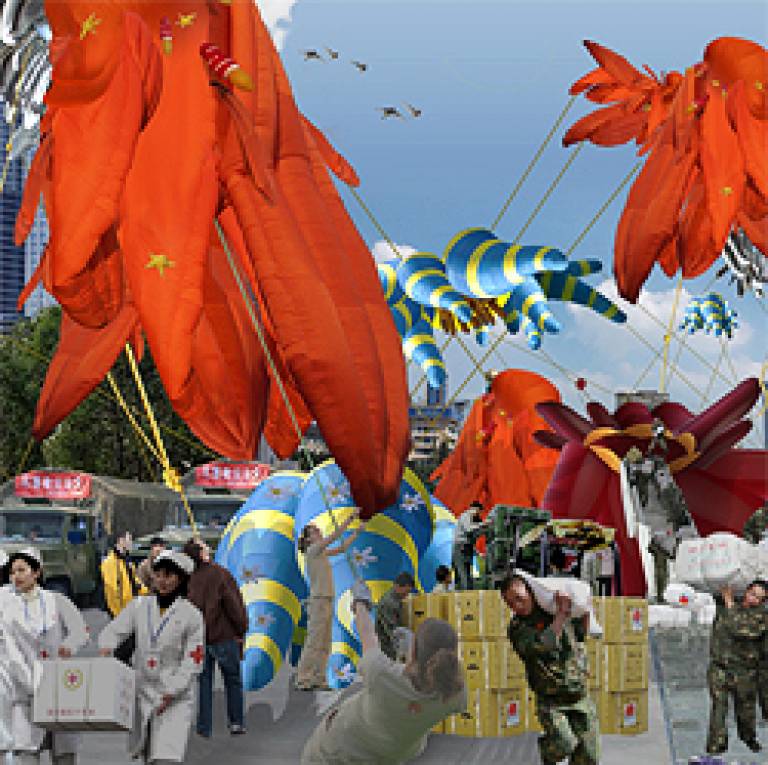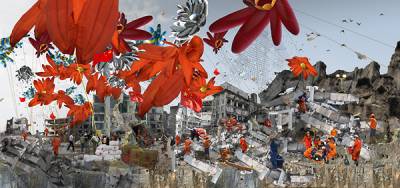Sichuan Earthquake Memorial
22 September 2008
Link:
 ucl.ac.uk/bartlett/people/?upi=CJLIM41" target="_self">Professor CJ Lim
ucl.ac.uk/bartlett/people/?upi=CJLIM41" target="_self">Professor CJ Lim
A proposal led by Professor CJ Lim (UCL Bartlett School of Architecture) has reached the final round of a competition to design a memorial for the nearly 70,000 people who died in the Sichuan Earthquake of May this year, and to bring aid to its survivors.
Lim's design for the Sichuan Earthquake Memorial Landscape is the "Thousand Flowers of Sichuan": a convoy of inflatable canopies that will float over the devastated city of Wenchuan, which was at the epicentre of the earthquake. It is conceived as a poetic skyscape, drawing on the motif of flowers as a symbol of remembrance. The vibrant colours and forms aim to bring energy and reassurance back to the community and represent a new spring as Wenchuan and the Sichuan Province undergo reconstruction.
In addition, Lim's proposal provides a practical means of connecting the city, whose transport infrastructure was largely destroyed, and bringing aid to at least five million people who were left homeless by the disaster. As landslides and uneven terrain have made aid missions extremely difficult by land or helicopter, Lim's flowers are designed to overcome these obstacles. The flowers perform on the same technical principles as the hot-air balloon, and are constructed out of lightweight materials with a large nylon surface area to maximise stability. Each flower envelope ranges from 15-30 metres in diameter, and can be folded up into a canvas bag to be loaded manually onto a truck.
From Chengdu, the convoy of inflatable flowers will provide previously unimaginable access and daily deliveries of temporary shelters, medical supplies, drinking water and food to the most damaged and irregular terrains. In contrast to a helicopter, the inflatable flowers can hover quietly over sites without causing further risks to unstable grounds. Flat landing surfaces are not required either as the flowers can dock in the sky with only ropes tethered to the ground for stability.
As aid parcels are gently lowered to the ground, the floating flowers will immediately 'blossom', extending their petals to give temporary shelters for aid distribution, and canopies of sympathy to survivors who gather daily amongst the rubble to remember their loved ones. The system of loosely connected canopies also gives refuge from rain and fierce sunshine to workers and volunteers clearing up the damage. At night, the glowing convoy of flowers can be seen from far and wide, while supplying electricity and light for the night-shift workers from its own self-sustainable generators. On the return journey to Chengdu, the floating convoy can be used to take large quantities of rubble to an out-of-town designated recycling zone.
Professor Lim said: "It has only been about two months since the earthquake hit Sichuan Province - the community is still in mourning, and requires time to assess before starting the process of clearing away the devastation and rebuilding the city. Therefore unlike other remembrance landmarks in the past, this memorial proposal is temporary, functional and flexible - intended for multi-locations. Planning and construction of memorial landmarks takes time, but this proposal can appear overnight."
To find out more about CJ Lim's work, follow the link at the top of this article.

Images: CJ Lim's 'Thousand Flowers of Sichuan' can bring aid to survivors as well as provide an immediate memorial to those lost in May's earthquake
 Close
Close

